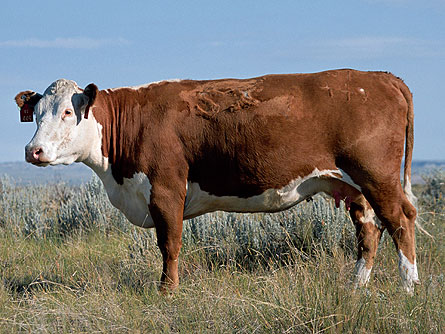- More than 2 years ago
Two competing research teams have cataloged the “essence of bovinity” found in the DNA of cattle, but not without disagreement on some essential points.
Reporting online April 23 in Science and April 24 in Genome Biology, the two groups compiled drafts of the bovine genome, identifying genes important for fighting disease, digesting food and producing milk.

“It gives you a window into what makes a cow a cow,” says Harris Lewin, of the University of Illinois at Urbana-Champaign, a coauthor of the Science paper. “There were some real surprises there.”
One surprise involved the gene that encodes the bacteria-busting enzyme lysozyme. Lysozyme in a cow’s second stomach breaks down bacteria into nutritious proteins. Humans have one copy of the gene. Cattle have a whopping 10, according to the draft genome published in Science by a team led by researchers at Baylor College of Medicine in Houston.
A second group, headed by Steven Salzberg of the University of Maryland in College Park, agreed with the lysozyme finding. But that group disputes some conclusions the Baylor team reached about gene duplications. The Science paper reported that many genes related to milk production and other cow-specific qualities were found in places called evolutionary breakpoints, unstable places where genomes rearrange during evolution. Milk-related genes were also expanded in these regions of gene rearrangements, meaning that many copies of the same gene were duplicated.
Salzberg says his team’s assembly of the DNA catalog indicates that the Baylor group reports many more duplications than really exist.
“There are hundreds of regions of DNA duplicated in their assembly that are not duplicated in our assembly,” Salzberg says. He acknowledged that some of the duplications are probably real, but he contends that “the majority of them are actually mis-assemblies and not real at all. So making biological conclusions about them is wrong.”
The two research teams used the same segments of DNA as starting puzzle pieces but stitched them together differently. “Assembling a genome is still very complicated. It’s not like doing a crossword puzzle, where there’s an answer and when you’re done, you’re done,” Salzberg says. “It’s more like building a bridge. You can give two people the same basic raw materials, and the bridge won’t really look the same.”
Similar regions of DNA could either be duplications in the genome or merely two samples of the same piece of DNA. Creating computer programs and algorithms that can tell the difference while putting together a genome is hard. “Segmental duplications are arguably the most difficult parts for assemblers to handle,” says Pavel Pevzner, a computational biologist at the University of California, San Diego who is familiar with assembling genomes.
Of the assembly led by Salzberg, Pevzner says: “I have no reason to doubt that they indeed generated a better assembly. I think it’s quite amazing how refinement of algorithms can improve the assembly.”
But the researchers are all quick to point out that these are just draft assemblies. “Any time you have highly duplicated segments and lots of rearrangements, you know you’re going to get things wrong,” Lewin says. “I think the issue is rapidly going to disappear as tons of new sequences come into the domain in the next year or two.”
Most of the DNA used in assembling the genome came from a single cow in Montana named L1 Dominette 01449. Lewin says he will soon be adding DNA sequences from two bulls to the mix, which will illuminate genes on the Y chromosome. His team is finishing up the sequences of what he describes as “two of the most important bulls in the Holstein breed.” The genetic makeup of these bulls, with their thousands of daughters, will give researchers and breeders even more valuable glimpses into what makes a cow a cow.
Knowing which genes keep a cow healthy and producing milk will benefit farmers around the world. “People have been breeding cattle for so long, but they don’t have the genes for many of those traits worked out. This will make identifying those genes so much easier,” says Kim Worley of Baylor, a coauthor of the Science paper.
In another study reported in the same issue of Science, researchers used DNA to track the changes of coat color in another domesticated animal — the horse. Examining ancient DNA, researchers found horse genes corresponding to new coat colors that appeared around the time of domestication. Those findings demonstrate human impact on animal genomes, says study coauthor Arne Ludwig of the Leibniz Institute for Zoo and Wildlife Research in Berlin, Germany. “Ancient farmers had a good anticipation about the mode of inheritance of several phenotypic traits long before genes were discovered,” he says.
Another Science report tracks down the mysterious lineage of domesticated sheep. By using tiny pieces of virus DNA integrated into the sheep DNA over time, researcher Massimo Palmarini of the University of Glasgow in Scotland and his team were able to pinpoint two distinct domestication events that molded the sheep genome — another example of how human activity in breeding animals had an impact on their genetic structure.






